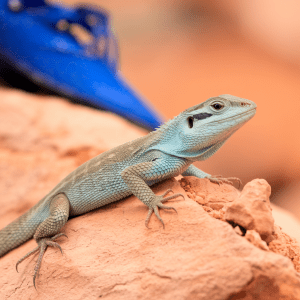Welcome to the fascinating world of gardening–but not just any gardening. Yes, you guessed right (or maybe not)–we're talking about creating a Lizard-Friendly Garden Microhabitat. Does it sound like a science project? Perhaps. Is it as intimidating as it sounds? Absolutely not!
You may be wondering why you'd want to invite lizards to your garden in the first place. But believe it or not, these little reptiles can be your garden's best friends. From helping with pest control to being simply delightful to observe, lizards can add fascinating dimensions to your backyard or patio.
We get it; you're just starting out on this lizard-friendly trip and it might feel a bit like you're in a thick jungle with no map. But don't sweat it because we're here as your friendly guides. Think of this introduction as your initiation to a new, exciting backyard adventure, as exciting as a family trip to an unexplored exotic island.
In this handy beginner trip itinerary (also known as a guide), we'll take you through the essentials of building a safe, sustainable environment for these garden allies. We'll touch on everything from selecting the right plants to step-by-step instructions for creating comfortable lizard shelters. By the time you're done reading, you'll be well on your way to nurturing your very own thriving, lizard-friendly habitat and transforming your family's outdoor space into a real-life nature reserve.
So come on, fellas, grab your gardening gloves and let's get ready to welcome some fantastic reptilian friends to your family garden! Did I forget to mention this will be fun? Well, it absolutely will be. Hang tight as we dive into this wonderful exploration!
Discover the exciting journey of creating Lizard-Friendly Garden Microhabitats, a beginner-friendly guide tailored for parents and families eager to transform their garden spaces. This comprehensive guide emphasizes the value lizards bring, from natural pest control to delightful garden companions, while offering clear, step-by-step instructions to design a safe, sustainable home for these fascinating reptiles. Embark on this fun, educational adventure and turn your backyard into a living nature reserve, fostering a thriving environment with ease.
Understanding Lizard-Friendly Garden Microhabitats: The Basics
Introduction to Creating Lizard-Friendly Landscapes
Creating a lush garden where lizards can frolic safely may initially seem like a daunting task, especially if you're a beginner. But let's approach this new challenge just like cooking your family's favorite recipe: One ingredient at a time, and before you know it, you've whipped up something magical. Alright, let's get started with your first slice of building lizard-friendly habitats in your backyard.
Designing homes for lizards requires simple adjustments to your usual gardening routine. This isn't just about creating a safe haven for these cute reptiles, but it's also about promoting biodiversity, learning about different species, and inspiring a passion for nature in your children. So, ready for your first step?
Step 1: Understand the Lizard's Natural Habitat
Just like how we prefer specific weather conditions and hometown characteristics, lizards also have a certain fondness for their native environment. Therefore, learning about a particular lizard species' natural habitat is an excellent starting point. It's just like researching your travel destination beforehand. Understanding what conditions they thrive in will help you recreate those in your garden.
The best part? You don't need to be a herpetologist (a lizard expert!) to do that. A quick online search, or a fun family trip to the local library, can provide the information you need. By the time you've completed this step, you've already set a strong foundation for your garden microhabitats project.
Step 2: Strategically Plan your Garden
Now that you're familiar with your lizard guests' preferred environment, begin assessing and planning your garden accordingly. Would they enjoy basking in the afternoon sun? Incorporate a sunny patch. Do they thrive on a balanced diet of bugs? Plant insect-attracting flora.
Remember, each decision you make is like adding another stop to your family's travel itinerary. In family travel, each destination is carefully selected for enjoyment and exploration. Similarly, each region in your garden should provide security, exploration, and nourishment for the lizards.
Don't get too worried about getting everything just right. Making a garden lizard-friendly is a process of trial and error; so, feel open to adapt and adjust as needed. Just like learning to ride a bike, it might feel tricky at first, but before you know it, you'll become a pro—and can watch these enchanting creatures thrive in the safety of your garden.
Creating "Lizard-Friendly Garden Microhabitats" begins with understanding the natural habitats of lizard species to effectively recreate them in your backyard, offering a safe haven for biodiversity. For beginners, this process involves simple adjustments, from planning a sunny garden patch to selecting the right insect-attracting plants, all while embracing a hands-on approach to trial and error. The key is to transform your gardening routine into an engaging and educational journey that fosters a deeper connection with nature.
Natural Lizard Allies: Why Lizards Are Beneficial for Your Garden

Creating Your First Lizard-Friendly Base Camp
Creating the perfect "Lizard-Friendly Garden Microhabitat" can feel daunting for beginners, especially if you're new to gardening or wildlife preservation. However, thinking of it as setting up an adventure base camp for your kids makes the process fun and easy to understand. Just like preparing the right travel equipment for a family camping trip, creating this special haven for lizards requires certain elements that make it feel homey and safe.
Step 1: Spot Selection – Your Expedition's Starting Point
First things first, choosing the right spot in your garden is crucial. You wouldn't set your family tent on a muddy hillside, would you? Similarly, lizards prefer dry, sunny places with plenty of cover. Try to locate a spot that gets at least 6-8 hours of sunlight daily. This will provide lizards with the warmth they need to thrive.
Step 2: Constructing Shelter – Building a Wildlife Tent
Now, let's build our wildlife tent! In the same way you'd set up a comfortable shelter for your family, lizards also need some protection from predators. Rocks, logs, and plant debris can become perfect hideouts for these little adventurers.
Step 3: Providing Food & Water – Preparing the Campfire and Water Station
Lastly, remember how important it is to have a water source and food ready at a campsite? It's the same for your garden guests. A shallow dish with water and planting bug-friendly plants can effectively meet their needs.
By following these steps you've successfully created a welcoming refuge for lizards in your family garden. Remember, it's all about making our reptile friends feel safe, warm and well-fed in their new base camp. As you move forward, remember there’s no rush—take it slow, you’re doing great!
Remember, setting up your first "Lizard-Friendly Garden Microhabitat" might seem daunting, but before you know it, it'll feel as natural as pitching a tent! Keep going, your backyard is about to become a delightful holiday spot for our scaly friends.
Breaking down this process into manageable steps can make setting up these welcoming microhabitats a lot simpler than it appears. So give it a try, it's easier than you think!
The section provides a beginner-friendly guide to creating "Lizard-Friendly Garden Microhabitats," simplifying the process by likening it to setting up a family camping base camp. It emphasizes selecting a sunny spot, constructing shelters using natural materials, and ensuring water and food availability to create a safe and welcoming environment for lizards. By breaking down these steps, the guide makes it easy and enjoyable for anyone to create a hospitable garden for their scaly friends.
Essentials of Creating Lizard-Friendly Environments: Key Components
Building Your First Lizard-Friendly Garden Microhabitat
Starting a new project can feel a little intimidating, particularly when it involves creating a tiny ecosystem that’s both kid-friendly and inviting to lizards. As any true explorer knows, a garden is not just a patch of green, but a home to numerous creatures. For adventurous families, transforming part of their garden into a lizard-friendly microhabitat is the perfect blend of learning and meaningful fun.
Step 1: Choosing the Right Spot
Creating a habitat to attract lizards means we'll need a sunny spot in your garden. Lizard-friendly zones should contain both shaded areas for cooling off and sunny patches for basking. Don't let this step intimidate you — think of it like choosing the perfect place for a picnic!
Step 2: Adding the Essentials
Now, we start equipping our little habitat. You could use rocks and logs to give it a natural, welcoming feel. Think of these additions as furniture in a room – it's where our tiny guests will hang out.
Step 3: Plant Choices
Just like moving to a new neighborhood full of fun amenities encourages families to set up home, the right kinds of plants can attract lizards. Succulents, grasses, and ferns are some favorites.
If you've gotten this far, then pat yourself on the back. You're making a fantastic start!
While making these garden adjustments, be mindful not to overpower the space. The goal is to have an inviting space that's also safe for your children to explore. So keep the spikes and thorns to a minimum. An excellent rule of thumb is not to add anything you wouldn't want your children to accidentally brush up against.
Building your first lizard-friendly microhabitat might seem like a big project. But remember, it's all about taking one small step at a time. Happy gardening!
Section Summary: Learn how to create a beginner-friendly lizard habitat in your garden. The environment should include a sunny spot, natural furniture like rocks and logs, and lizard-attracting plants. Ensure that the space is also safe for children to explore. Building your first lizard-friendly garden microhabitat can be a fun and educational family activity.
This section guides beginners on building "Lizard-Friendly Garden Microhabitats" by combining educational fun with family bonding. Start by selecting a sunny spot and add natural elements like rocks and logs to appeal to lizards. Incorporate suitable plants like succulents, grasses, and ferns to attract lizards while ensuring the space remains child-safe for exploration.
Selecting Plant Species That Support Lizard-Friendly Garden Microhabitats
Starting with Your Lizard-Friendly Garden Microhabitats: Creating a Natural Haven
Feeling a bit overwhelmed? Just like you would prepare for a family vacation, some pre-flight checks are necessary. Don’t sweat it though, it’s actually much simpler than you might think.
Firstly, remember we are making a small eco-friendly habitat for our scaly friends. That’s right, your garden is about to turn into a backyard sanctuary that is not only visually appealing but also serves as a safe haven for your lizard buddies! So, don't worry about making giant leaps, just let's take it step by step.
Your First Move: Knowing Your Residents
Understanding the types of lizards local to your area is a great launching pad. Different species require different caring strategies; just like how each family member has their own travel preferences. So, do a bit of research, it’s easier than it seems!
Step 2: Building Your Lizard Habitat
Think of it as preparing your garden for a friendly gathering; you would want various spots where your guests could chill, right? The same applies here – a bit of shade, sunlight, rocks for basking, and plant cover are crucial elements.
Step 3: Keep it Natural and Maintain Balance
Avoid using pesticides or any harmful chemicals in your garden, it’s much like ensuring your travel destination has safe drinking water, essential for survival! Lizards naturally keep pests in control, so it’s a win-win situation. Creating this form of natural microhabitat for lizards is contributing to a healthier and sustainable ecosystem.
Remember the joy when your little one took their first vacation steps in the sand? That's exactly what it feels like witnessing your Lizard-friendly garden flourishes. Don't worry if some steps seem difficult, in fact, they're more fun than challenging – just like assembling a travel kit. If at any point you get stuck, use this guide as your roadmap. You're doing great, keep going!
In the spirit of transparency and openness, don't hesitate to ask for advice or share your experience with others who share the passion. Creating your Lizard-friendly Garden Microhabitats is an adventurous journey, and there's lots of fun to be had along the way. Enjoy the ride!
Starting your journey into creating "Lizard-Friendly Garden Microhabitats" can be simple and rewarding by taking it step by step. First, familiarize yourself with local lizard species to tailor your garden to their needs, then focus on crafting a balanced habitat with elements like shade, sunlight, and natural pest control to support their well-being. Embrace this fun and adventurous project as you build a sustainable, eco-friendly backyard sanctuary for your new reptilian friends.
DIY Tips for Building Simple Lizard Shelters and Hideaways
Creating Your First Lizard-Friendly Garden Microhabitat
Starting something new can sometimes feel overwhelming, but here’s an easy way to dip your toes into the fascinating world of “Lizard-Friendly Garden Microhabitats.” It's simpler than you might think! Let’s walk through the creation process together.
Planning Your Microhabitat
Your first move involves determining a suitable location for a microhabitat that caters to lizards’ needs. Consider locations that offer a mix of sun and shade, where lizards can bask and retreat as required.
Choosing the Right Plants
Plants are essential. They provide lizards with shelter, a food source, and even a place for laying eggs. Consider native plants to your local area, as these will be most attractive to local lizards.
Incorporating Essential Hideouts
Next, we should add places for lizards to hide. Rocks, logs, leaves, and even ceramic pots can form perfect hideouts.
Water and Food Supply
Adding a shallow water dish will ensure the lizards stay hydrated. While lizards do eat garden pests, during initial setup, you might need to supplement their diet with store-bought food.
Don’t worry if you find this challenging; it's easier than it seems once you get started. If you feel stuck here, try moving on to the next step and return later. It's your area of sanctuary designed for these cold-blooded friends to relax, eat, and sleep.
So give it a try, you're building not just a mini-ecosystem but an exciting outdoor attraction for your family's next adventure. Remember, it's okay if you don't get it perfect the first time around. You're doing great—keep going!
So let's get started on your journey in crafting garden habitats designed specifically for lizards. If you've reached this step, you're already making excellent progress! With a little patience and dedication, your lizard-friendly garden microhabitat will soon be ready for its new tenants.
Isn't it exciting? Your very own lizard-friendly habitat could be the highlight of your next family 'staycation'. Keep up the hard work! It's going to be worth it.
Creating your first lizard-friendly garden microhabitat can be a rewarding and accessible project for beginners, offering both an engaging outdoor activity and a learning opportunity. By planning a location with a mix of sun and shade, choosing native plants, incorporating essential hideouts, and ensuring a water and food supply, you can craft a thriving micro-ecosystem for lizards with ease. This journey not only supports local wildlife but also transforms your garden into an exciting attraction for family adventures.
Maintaining Your Lizard Oasis: Long-Term Care and Sustainability
Section: Creating Your Lizard-Friendly Garden Microhabitat: Taking the First Leap
Getting started on a new project can be intimidating, especially when it involves creatures as unique as reptiles. But fear not! Creating lizard-friendly microhabitats in your garden is much simpler than you might imagine. Think of it as setting up a miniature outdoor playground for your kids. It's about ensuring the right conditions and adding elements that keep the little ones – in this case, the lizards – happy and healthy.
Step 1: Choose the Ideal Spot
The first move in building your eco-friendly corner for lizards is selecting the perfect location in your garden. It should be a place with a mix of sunlight and shade that matches the natural habitat of the lizard species you're targeting.
Tips on Weather Conditions
Remember, just like your family enjoys varying weather on their travels, different lizard species prefer distinct climate conditions. For instance, if you’re creating an environment for a sun-loving species, you would choose a site with substantial exposure to sunlight. Conversely, a cooler, shaded spot would suit a species that thrives in lower temperatures.
Step 2: Creating Hiding Places
Your next step is creating hiding places or shelters. These can be piles of rocks, pieces of bark, piles of leaves, or logs. Just like your children enjoy a cozy fort or treehouse, these spots offer the lizards a safe retreat.
The Art of Balancing
If you feel overwhelmed by all the different elements, don't fret! Think about it like packing a mixed bag for a family vacation – some items for the beach, some for the mountains, ensuring something for everyone. Nature is all about balance, and a little bit of everything in moderation creates the ideal conditions for a lizard-friendly garden microhabitat.
Remember, you're taking the first steps towards becoming a local warrior for wildlife preservation, making your garden more than just visually delightful, but also hospitable to local fauna. It’s much simpler than it seems, and with each completed step, you're making progress. Keep going!
Creating "Lizard-Friendly Garden Microhabitats" is an approachable and rewarding project, perfect for beginners looking to support local wildlife. Start by selecting an area in your garden that balances sunlight and shade to match the natural preferences of your targeted lizard species. Then, add hiding places like rocks and leaves, remembering that achieving harmony is much like packing a varied suitcase for a family trip—each element plays a crucial role in crafting a welcoming habitat.
Congratulations on reaching the end of your journey with our guide to "Lizard-Friendly Garden Microhabitats"! You've taken the first exciting steps towards transforming your garden into a haven for these remarkable creatures. Remember how overwhelming it all seemed at first? Now look at how much you've achieved — from selecting sunny spots to crafting cozy hideaways with rocks and natural materials. You've already made amazing progress toward mastering this rewarding project!
By incorporating elements like suitable plants for attracting lizards, providing essential water sources, and creating balanced sun and shade areas, you're not only supporting local biodiversity but also turning your backyard into an adventure-filled nature reserve for your family. You've learned to blend educational fun with memorable family experiences — a true testament to your dedication and openness to learning.
Why not take the next step today and try a small project, like adding a new plant or adjusting your garden's layout? You're well-equipped with all the knowledge you need to enhance your space further. It's easier than you might think, and each small effort delivers big rewards.
So, as you set off to create your own lizard-friendly microhabitats, remember this: it's not just about providing a home for lizards—it's about connecting with nature, encouraging curiosity, and sharing it all with your loved ones. You’re already well on your way to building a sustainable and lively garden. Who would've thought these steps could be this straightforward and fun? You're ready to continue with confidence, creating exciting, new adventures for you and your family right in your own backyard!
Embrace this engaging journey, and watch as your garden and its newfound inhabitants thrive. Happy gardening!
FAQ:
Question: How do I start building a reptile-friendly home in my garden?
Begin by observing your garden for an area that receives ample sunshine, as lizards love basking in warmth. Use natural materials like stones, logs, and leaves to create cozy shelters. Select plants that attract insects, a favorite snack for these scaly visitors, and ensure a small water source nearby. The goal is to balance various elements like sun, shade, and shelter to make your garden inviting. With simple, gradual steps, you can transform your backyard into a welcoming sanctuary, much like setting up a friendly camp for a new group of outdoor enthusiasts.
Question: What type of plants should I include to attract these small garden visitors?
Opt for native plants, as local greenery naturally attracts insects that lizards feast on. Consider integrating succulents, grasses, and low-growing shrubs to provide both coverage and food. These plants offer shade, shelter, and attract insects, meeting the needs of your small, scaly friends. Native vegetation requires less maintenance and adapts better to the local climate, thriving in your garden quickly. By choosing the right greenery, you'll create a self-sustaining haven that lizards will happily call home, all while keeping your garden vibrant and lush.
Question: How can I ensure the garden is safe for both lizards and children?
Safety can be achieved by avoiding the use of chemicals like pesticides, which can harm both lizards and children. Instead, focus on natural pest control methods, such as introducing insect-attracting plants. Ensure that sharp or heavy objects are securely positioned to prevent accidents during play. Use smooth rocks and logs to create hiding spots that are safe for curious young hands. With a mindful approach, your garden can be a nurturing environment for learning and exploration that allows both children and lizards to safely enjoy the space you're creating together.
Question: What if lizards don't appear in my garden right away?
Patience is key in nature. It might take some time for lizards to discover and move into their new sanctuary. Continue maintaining the garden, ensuring a healthy mix of sun, shade, water, and food. Monitor local conditions, like temperature and weather, which can influence lizard activity. By consistently providing a balanced, inviting environment, you'll improve the chances of attracting them over time. Remember, transforming your garden into a reptile haven is a delightful journey—one that fosters learning, patience, and ultimately, the joy of seeing wildlife thrive right in your backyard.



